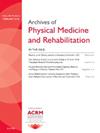导航时间(TTN):用于冻结帕金森病患者步态严重程度的实用客观临床测量方法。
IF 3.7
2区 医学
Q1 REHABILITATION
Archives of physical medicine and rehabilitation
Pub Date : 2025-02-01
DOI:10.1016/j.apmr.2024.09.003
引用次数: 0
摘要
研究目的:由于现有的步态冻结(FOG)严重程度客观评估对于常规临床实践而言可能过于笨重,为了提供一种易于使用的测量方法,本研究探讨了完成最近通过验证的 FOG 严重程度工具及其组成部分所需的时间:设计:横断面设计:横断面研究 场景:一家三甲医院的门诊部 参与者:能够进行自我评估的帕金森病患者:连续招募能够独立行走八米、理解指令且无影响步态的并发症的帕金森病患者。共纳入 35 名参与者[82.9%(n=29)为男性;中位数(IQR):年龄 - 73.0(11.0)岁;病程 - 4.0(4.5)年]:主要结果测量:在视频分析过程中使用秒表记录每个部分的时间。通过与经过验证的 FOG 严重程度结果的相关性,对 FOG 严重程度工具的总时间、完成转弯和窄空间部分所需的时间(即导航时间,TTN)以及调整后的 TTN 的有效性进行了检验。为便于临床解释,采用散点图平滑(LOESS)回归法确定 TTN 临界值,同时采用预测建模法计算最小重要变化(MIC):结果:FOG 严重程度工具时间、TTN 和调整后的 TTN 与 FOG 问卷和 FOG 百分比呈中度相关,与 FOG 严重程度工具修订版呈高度相关。TTN 与 FOG 严重程度呈非线性关系,在最初的 300 秒内呈正相关,之后则趋于平稳。TTN的MIC值为时间缩短15.4秒(95%CI为3.2至28.7):结论:TTN 是一种可行、可解释且有效的 FOG 严重程度测试方法。在繁忙的临床环境中,当使用现有的客观 FOG 测量方法(通常)不可行时,TTN 可以提供一种可行的替代方法。本文章由计算机程序翻译,如有差异,请以英文原文为准。
Time to Navigate: A Practical Objective Clinical Measure for Freezing of Gait Severity in People With Parkinson Disease
Objectives
To provide an easy-to-use measure, as existing objective assessments for freezing of gait (FOG) severity may be unwieldy for routine clinical practice, this study explored time taken to complete the recently validated FOG severity tool and its components.
Design
A cross-sectional study.
Setting
Outpatient clinics of a tertiary hospital.
Participants
People with Parkinson disease who could independently ambulate 8-meters, understand instructions, and without co-morbidities affecting gait were consecutively recruited. Thirty-five participants were included (82.9% [n=29] male; median [IQR]: age of 73.0 [11.0] years and disease duration of 4.0 [4.5] years).
Interventions
Not applicable.
Main Outcome Measures
Participants were assessed with the FOG severity tool in a test-retest design, with time taken for each component recorded using a stopwatch during video-analysis. Validity of total FOG severity tool time, time taken to complete its turning and narrow-space components (i.e., time to navigate [TTN]), and an adjusted TTN were examined through correlations with validated FOG severity outcomes. To facilitate clinical interpretation, the TTN cut-off was determined using scatterplot smoothing regression, whereas minimal important change was calculated using predictive modeling.
Results
The FOG severity tool time, TTN, and adjusted TTN similarly demonstrated moderate correlations with the FOG questionnaire and percentage-FOG, and very high correlations with FOG severity tool–revised. The TTN was nonlinearly related to FOG severity, with a positive relationship observed in the first 300 seconds and plateauing after. minimal important change for TTN was 15.4 seconds reduction in timing (95% CI, 3.2-28.7).
Conclusions
The TTN is a feasible, interpretable, and valid test of FOG severity. In busy clinical settings, TTN can provide a viable alternative when use of existing objective FOG measures is (often) unfeasible.
求助全文
通过发布文献求助,成功后即可免费获取论文全文。
去求助
来源期刊
CiteScore
6.20
自引率
4.70%
发文量
495
审稿时长
38 days
期刊介绍:
The Archives of Physical Medicine and Rehabilitation publishes original, peer-reviewed research and clinical reports on important trends and developments in physical medicine and rehabilitation and related fields. This international journal brings researchers and clinicians authoritative information on the therapeutic utilization of physical, behavioral and pharmaceutical agents in providing comprehensive care for individuals with chronic illness and disabilities.
Archives began publication in 1920, publishes monthly, and is the official journal of the American Congress of Rehabilitation Medicine. Its papers are cited more often than any other rehabilitation journal.

 求助内容:
求助内容: 应助结果提醒方式:
应助结果提醒方式:


